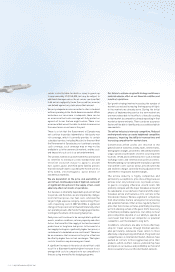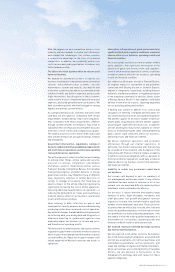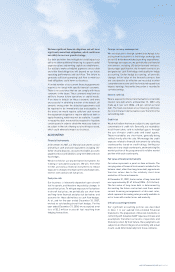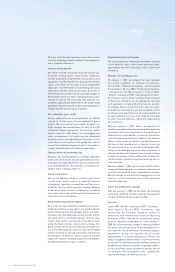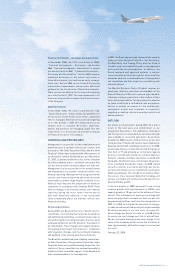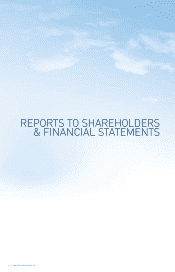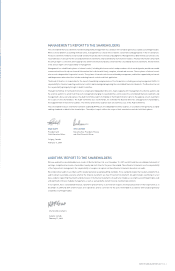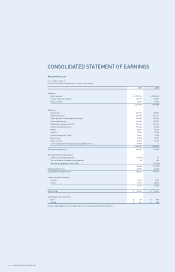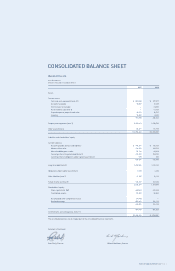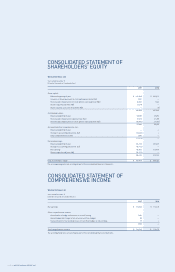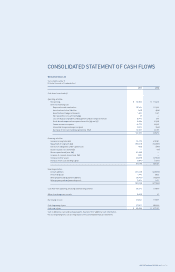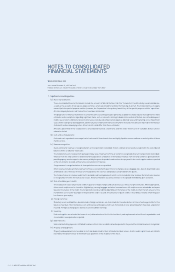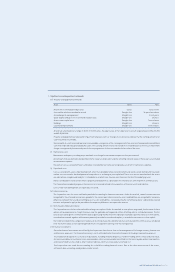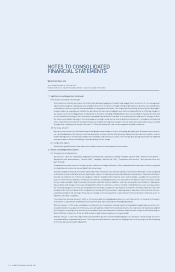Westjet 2007 Annual Report Download - page 40
Download and view the complete annual report
Please find page 40 of the 2007 Westjet annual report below. You can navigate through the pages in the report by either clicking on the pages listed below, or by using the keyword search tool below to find specific information within the annual report.
PAGE 38 WESTJET ANNUAL REPORT 2007
We have identifi ed the following areas that contain
critical accounting estimates utilized in the preparation
of our fi nancial statements:
Property and equipment
We make estimates about the expected useful lives,
projected residual values, lease-return conditions,
and the potential for impairment of our property and
equipment. In estimating the lives and expected residual
values of our fl eet, we rely upon annual independent
appraisals, recommendations from Boeing and actual
experience with the same aircraft types. Revisions to
the estimates for our fl eet can be caused by changes in
the utilization of the aircraft or changing market prices
of used aircraft of the same type. We evaluate our
estimates and potential impairment on all property and
equipment annually and when events and circumstances
indicate that the assets may be impaired.
Non-refundable guest credits
We also make estimates in accounting for our liability
related to certain types of non-refundable guest
credits. We issue future travel credits to guests for
fl ight changes and cancellations, as well as for gift
certifi cates. Where appropriate, future travel credits
are also issued for fl ight delays, missing baggage and
other inconveniences. All credits are non-refundable
and expiry dates vary depending on the nature of the
credit. We record a liability in the period the credit is
issued. The utilization of guest credits is recorded as
revenue when the guest has fl own or upon expiry.
Deferred sales and marketing costs
We defer sales and marketing costs related to advanced
ticket sales. We estimate the amount to defer based on
the proportion of advanced ticket sales to total bookings
on an annualized basis. This amount is included on our
balance sheet in prepaid expenses.
Future income taxes
We use the liability method of accounting for future
income taxes, which requires a signifi cant amount
of judgment regarding assumptions and the use of
estimates. This can create signifi cant variances between
actual results and estimates, including the scheduling
of our effective tax rate and the potential realization of
future tax assets and liabilities.
Stock-based compensation expense
We use the fair value method for valuing stock options.
Under this method, as new options are granted, the fair
value of these options will be expensed on a straight-
line basis over the applicable vesting period, with an
offsetting entry to contributed surplus. The fair value
of each option grant is estimated on the date of grant
using the Black-Scholes option pricing model. The
Black-Scholes option pricing model was developed for
use in estimating the fair value of short-term traded
options that have no vesting restrictions and are fully
transferable. In addition, option valuation models
require the input of somewhat subjective assumptions
including expected stock price volatility.
Financial derivative instruments
The carrying amounts of fi nancial instruments included
in the balance sheet, other than long-term debt,
approximate their fair value due to their short term
to maturity.
Changes in accounting policies
On January 1, 2007, we adopted the new Canadian
accounting standards for financial instruments:
Section 3861, “Financial Instruments – Disclosure and
Presentation,” Section 3855, “Financial Instruments
– Recognition and Measurement,” Section 3865,
“Hedges” and Section 1530, “Comprehensive Income”.
Prior periods have not been restated. Under adoption
of these new standards, we designated our cash and
cash equivalents, including US-dollar deposits, as held-
for-trading, which is measured at fair value. Accounts
receivable are classifi ed as loans and receivables, which
are measured at amortized cost. Accounts payable and
accrued liabilities and long-term debt are classifi ed
as other fi nancial liabilities, which are measured at
amortized cost.
Effective January 1, 2007, and as provided for on
transition, we selected a policy of immediately expensing
transaction costs incurred related to the acquisition of
fi nancial assets and liabilities. Previously, transaction
costs had been deferred and included on the balance
sheet as other assets or liabilities and amortized over
the term of the related asset or liability. Under the
transitional provisions, we retrospectively adopted this
change in accounting policy without the restatement of
prior-period fi nancial statements and incurred a charge
to retained earnings of $36.6 million (net of future tax
of $16.3 million) related to legal and fi nancing fees on
long-term debt.
Effective January 1, 2007, we transferred $13.4 million
of unamortized hedging losses related to certain leased
aircraft to accumulated other comprehensive income.
We will continue to amortize the hedging losses to net
earnings over the remaining term of the previously
related hedged item.
Future accounting policy changes
Effective January 1, 2008, we will adopt the following
accounting standards recently issued by the Canadian
Institute of Chartered Accountants (CICA):
Inventory
In June 2007, the CICA issued Section 3031, “Inventories,”
which replaces Section 3030, “Inventories,” and
harmonizes the Canadian standards related to
inventories with International Financial Reporting
Standards (IFRS). Effective for interim and annual
fi nancial statements beginning on or after January 1,
2008, this section provides changes to the measurement
and more extensive guidance on the determination of
cost, narrows the permitted cost formulas, requires
impairment testing, and expands the disclosure
requirements to increase transparency. Entities can
choose to apply the standard either to opening inventory
for the period, adjusting opening retained earnings by
the difference in the measurement of opening inventory,
or retrospectively, by restating prior periods. We do
not anticipate that the adoption of this standard will
signifi cantly impact our fi nancial results.




